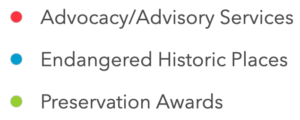Do you have a preservation-related question or concern?
We’re here to help!
Please submit an Inquiry Form to request a preservation consultation. We work with all Long Islanders; from historic property owners and businesses, to nonprofits and municipalities.
Submit an Inquiry FormLooking for funding to support a preservation project or program?
Follow the links below to explore grant opportunities for Long Island. Please contact the grant-making organization directly for more information about eligibility or how to apply.
Grants from the Preservation League of NYS
Grants from the Robert David Lion Gardiner Foundation
Grants from the New York State Council on the Arts (NYSCA)
Grants from the William G. Pomeroy Foundation
Historic Preservation Grant Program, NYS Office of Parks, Recreation and Historic Preservation
Conservation Treatment Grant Program, NYSCA/Greater Hudson Heritage Network (GHHN)
FAQs and Resources:
Sponsoring a Historic District Nomination (National Register): Follow the link to a guide by the New York State Historic Preservation Office outlining the steps and process of sponsoring a new historic district nomination.
Federal and State Historic Tax Credit Programs: Owners of historic income-producing real property, owner-occupied homes, and barns may qualify for a tax credit for rehabilitating the property. Please also visit the Preservation League of NYS website for additional information and signup for their insightful historic tax credit workshops.
Local Preservation Laws: Regulation at the local level by cities, villages, and towns provides the strongest protection for historic resources on Long Island and across New York State.
Certified Local Government (CLG) Program: Any city, county, town, or village in New York State can be a CLG, once the New York State Historic Preservation Office (SHPO) and National Park Service determine that it meets state and federal standards. These standards include having adopted an appropriate historic preservation ordinance and appointing a qualified preservation review commission. All certified CLGs may receive direct support from the SHPO, including special grants and services to directly support local preservation activities and long-term preservation goals. Click HERE to find out if your community is a CLG.
Sensitive Approaches to Rehabilitation and Maintenance: When planning to do work on a historic property, applying general preservation principles will help ensure the property’s significant architectural and historical features.
Design Guidelines: Administration of local preservation ordinances may be supported by design guidelines, which provide property owners with helpful recommendations for ensuring their proposed projects meet the design review criteria required by local preservation ordinance. Design guidelines often include written and graphic information to enhance the clarity and efficiency of the review process for members of preservation commissions and boards as well as applicants. Some examples of guidelines provided by municipalities on Long Island include:
- The Village of Roslyn’ Historic District Board Guidelines
- The Village of Southampton’s Architectural Design Guidelines for Historic Districts and Landmarks
- The Town of Huntington’s Preservation Guidelines
Regulating New Construction in Historic Districts: The design and review of plans for new construction in a historic district differ from the design and review of plans for the rehabilitation or repair of an existing historic building. This publication from the National Trust for Historic Preservation explains how to enhance the success of new construction projects through the design review process, as well as different approaches to new construction in historic settings.
Preservation Easements: A legal tool for preservation that can offer flexibility and other benefits.
State Environmental Quality Review (SEQR): In New York State, most projects or activities proposed by a state agency or unit of local government (e.g., infrastructure expansion), and all discretionary approvals (e.g., subdivision approval) from a state agency or unit of local government, require an environmental impact assessment as prescribed by SEQR. For example, a Full Environmental Assessment Form (FEAF), or a Short Environmental Assessment Form (Short EAF) may be required for a proposed action impacting the character or quality of important historic, archaeological, architectural or aesthetic resources.
- Under SEQR law, potentially significant adverse impacts on archeological and historic resources must be considered and a plan to mitigate or avoid such impacts developed. Moreover, nothing in SEQR precludes or prevents attention to historic resources identified during the process of review, public comment and fact-finding, even if those resources are not yet listed or nominated for listing on the National Register. Consequently, SEQR broadly defines “historic” as an element of the environment itself, as well as one of the physical conditions potentially affected by a project: “Environment means the physical conditions that will be affected by a proposed action, including land, air, water, minerals, flora, fauna, noise, resources of agricultural, archeological, historic or aesthetic significance, existing patterns of population concentration, distribution or growth, existing community or neighborhood character, and human health” [6 NYCRR Part 617.2(l)].
Learn more about historic preservation!
Preservation Long Island advocates for preservation throughout our geographical region!
Where have we been lately? Take a look…
Preservation Programs and Services 2019-2020





